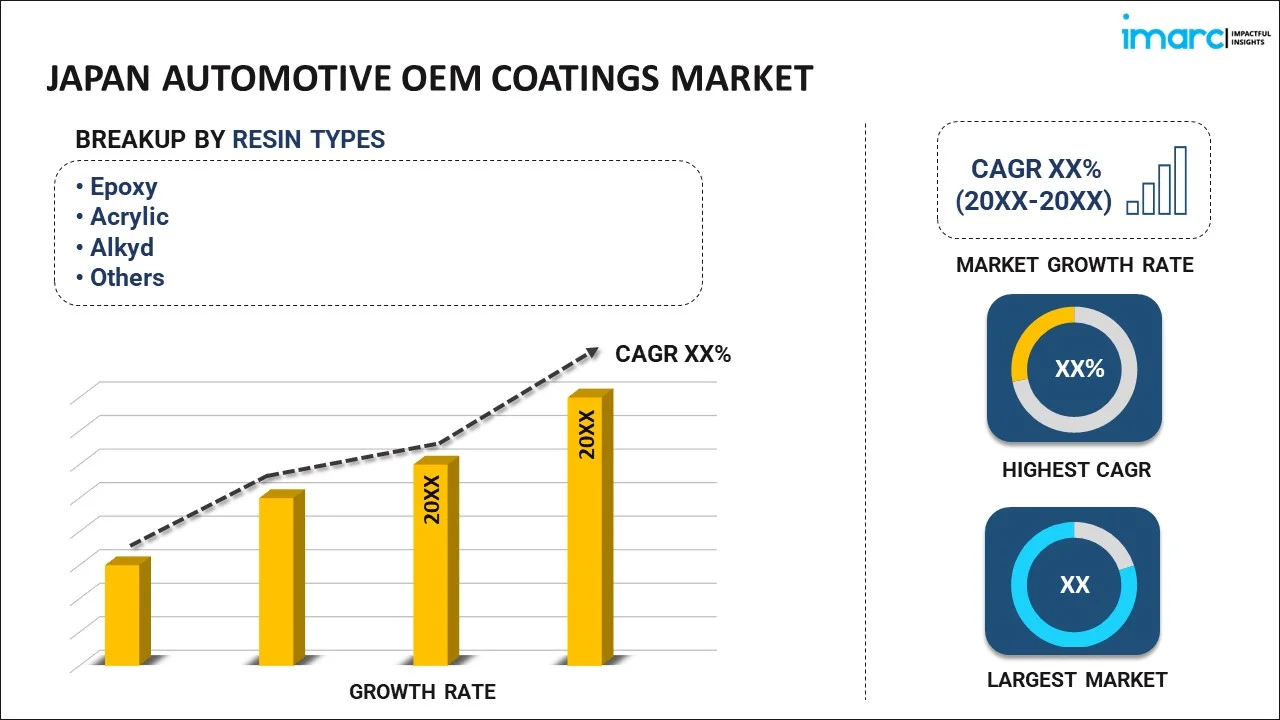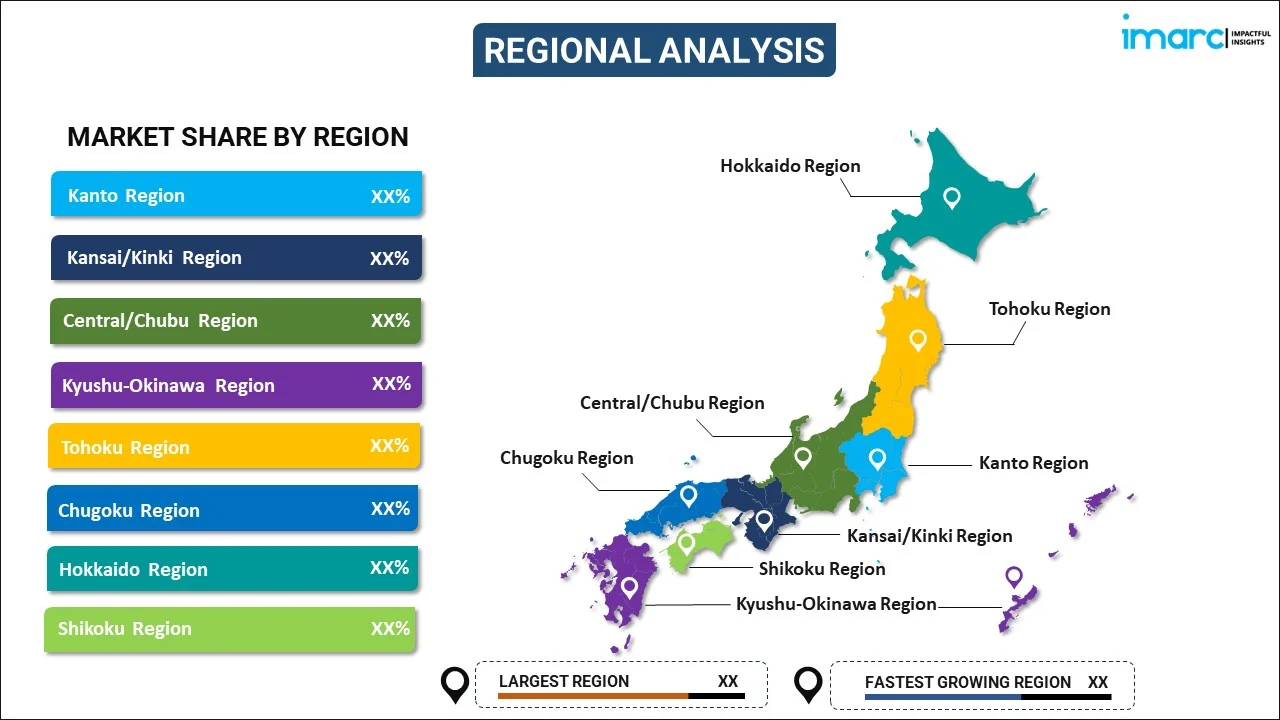
Japan Automotive OEM Coatings Market Report by Resin Type (Epoxy, Acrylic, Alkyd, Polyurethane, Polyester, and Others), Technology (Water-borne, Solvent-borne, and Others), End User (Passenger Cars, Commercial Vehicles, ACE (Agricultural, Construction and Earthmoving Equipment)), and Region 2025-2033
Market Overview:
Japan automotive OEM coatings market size reached USD 1,030.0 Million in 2024. Looking forward, IMARC Group expects the market to reach USD 1,359.2 Million by 2033, exhibiting a growth rate (CAGR) of 3.33% during 2025-2033. The increasing demand for commercial utility vehicles, along with the growing integration of ultraviolet (UV)-curved technologies and eco-friendly coatings, is primarily driving the market growth.
|
Report Attribute
|
Key Statistics
|
|---|---|
|
Base Year
|
2024 |
|
Forecast Years
|
2025-2033 |
|
Historical Years
|
2019-2024
|
| Market Size in 2024 | USD 1,030.0 Million |
| Market Forecast in 2033 | USD 1,359.2 Million |
| Market Growth Rate (2025-2033) | 3.33% |
Automotive OEM coatings play a pivotal role in the automotive industry, serving as the protective and aesthetic skin of vehicles right off the assembly line. These coatings are meticulously engineered to provide a dual function: safeguarding the vehicle's structural integrity and enhancing its visual appeal. In terms of protection, automotive OEM coatings are formulated to shield the vehicle's metal surfaces from corrosion, UV radiation, and environmental contaminants. This not only ensures the longevity of the vehicle but also maintains its resale value. Moreover, these coatings offer robust resistance against mechanical wear and tear, preventing scratches and abrasions during transportation and assembly. Beyond protection, automotive OEM coatings are chosen to elevate the car's aesthetic appeal. They come in a myriad of colors and finishes, allowing manufacturers to cater to diverse consumer preferences. The quality and precision of these coatings contribute significantly to the vehicle's final appearance, reflecting the brand's identity and commitment to excellence.
Japan Automotive OEM Coatings Market Trends:
The automotive OEM coatings market in Japan is observing substantial growth, driven by a confluence of factors that are cohesively shaping the market trajectory. The escalating demand for automobiles owing to a burgeoning regional population and rising disposable income is acting as the primary driver of market growth. Additionally, the inflating environmental concerns that are compelling manufacturers to develop eco-friendly coatings, such as water-borne and powder coatings, are also augmenting the Japan automotive OEM coatings market. This development is crucially intertwined with increasingly stringent environmental regulations that mandate the reduction of volatile organic compounds (VOCs). Moreover, the relentless pursuit of innovation in the automotive industry, underscored by the adoption of advanced materials and production technologies, is fueling the demand for specialized coatings that offer enhanced properties like improved durability and resistance to environmental factors. Apart from this, the emerging usage of electric vehicles (EVs) and autonomous vehicles, since they require coatings that can meet the unique demands of these new vehicle types, such as resistance to electrical interference and enhanced thermal management, is expected to drive the Japan automotive OEM coatings market during the forecast period.
Japan Automotive OEM Coatings Market Segmentation:
IMARC Group provides an analysis of the key trends in each segment of the market, along with forecasts at the country level for 2025-2033. Our report has categorized the market based on resin type, technology and end user.
Resin Type Insights:

- Epoxy
- Acrylic
- Alkyd
- Polyurethane
- Polyester
- Others
The report has provided a detailed breakup and analysis of the market based on the resin type. This includes epoxy, acrylic, alkyd, polyurethane, polyester, and others.
Technology Insights:
- Water-borne
- Solvent-borne
- Others
A detailed breakup and analysis of the market based on the technology have also been provided in the report. This includes water-borne, solvent-borne, and others.
End User Insights:
- Passenger Cars
- Commercial Vehicles
- ACE (Agricultural, Construction and Earthmoving Equipment)
A detailed breakup and analysis of the market based on the end user have also been provided in the report. This includes passenger cars, commercial vehicles, and ACE (agricultural, construction and earthmoving equipment).
Regional Insights:

- Kanto Region
- Kansai/Kinki Region
- Central/ Chubu Region
- Kyushu-Okinawa Region
- Tohoku Region
- Chugoku Region
- Hokkaido Region
- Shikoku Region
The report has also provided a comprehensive analysis of all the major regional markets, which include Kanto Region, Kansai/Kinki Region, Central/ Chubu Region, Kyushu-Okinawa Region, Tohoku Region, Chugoku Region, Hokkaido Region, and Shikoku Region.
Competitive Landscape:
The market research report has also provided a comprehensive analysis of the competitive landscape. Competitive analysis such as market structure, key player positioning, top winning strategies, competitive dashboard, and company evaluation quadrant has been covered in the report. Also, detailed profiles of all major companies have been provided.
Japan Automotive OEM Coatings Market Report Coverage:
| Report Features | Details |
|---|---|
| Base Year of the Analysis | 2024 |
| Historical Period | 2019-2024 |
| Forecast Period | 2025-2033 |
| Units | Million USD |
| Scope of the Report | Exploration of Historical Trends and Market Outlook, Industry Catalysts and Challenges, Segment-Wise Historical and Future Market Assessment:
|
| Resin Types Covered | Epoxy, Acrylic, Alkyd, Polyurethane, Polyester, Others |
| Technologies Covered | Water-borne, Solvent-borne, Others |
| End Users Covered | Passenger Cars, Commercial Vehicles, ACE (Agricultural, Construction and Earthmoving Equipment) |
| Regions Covered | Kanto Region, Kansai/Kinki Region, Central/ Chubu Region, Kyushu-Okinawa Region, Tohoku Region, Chugoku Region, Hokkaido Region, Shikoku Region |
| Customization Scope | 10% Free Customization |
| Post-Sale Analyst Support | 10-12 Weeks |
| Delivery Format | PDF and Excel through Email (We can also provide the editable version of the report in PPT/Word format on special request) |
Key Questions Answered in This Report:
- How has the Japan automotive OEM coatings market performed so far and how will it perform in the coming years?
- What has been the impact of COVID-19 on the Japan automotive OEM coatings market?
- What is the breakup of the Japan automotive OEM coatings market on the basis of resin type?
- What is the breakup of the Japan automotive OEM coatings market on the basis of technology?
- What is the breakup of the Japan automotive OEM coatings market on the basis of end user?
- What are the various stages in the value chain of the Japan automotive OEM coatings market?
- What are the key driving factors and challenges in the Japan automotive OEM coatings market?
- What is the structure of the Japan automotive OEM coatings market and who are the key players?
- What is the degree of competition in the Japan automotive OEM coatings market?
Key Benefits for Stakeholders:
- IMARC’s industry report offers a comprehensive quantitative analysis of various market segments, historical and current market trends, market forecasts, and dynamics of the Japan automotive OEM coatings market from 2019-2033.
- The research report provides the latest information on the market drivers, challenges, and opportunities in the Japan automotive OEM coatings market.
- Porter's five forces analysis assist stakeholders in assessing the impact of new entrants, competitive rivalry, supplier power, buyer power, and the threat of substitution. It helps stakeholders to analyze the level of competition within the Japan automotive OEM coatings industry and its attractiveness.
- Competitive landscape allows stakeholders to understand their competitive environment and provides an insight into the current positions of key players in the market.
Need more help?
- Speak to our experienced analysts for insights on the current market scenarios.
- Include additional segments and countries to customize the report as per your requirement.
- Gain an unparalleled competitive advantage in your domain by understanding how to utilize the report and positively impacting your operations and revenue.
- For further assistance, please connect with our analysts.
 Inquire Before Buying
Inquire Before Buying
 Speak to an Analyst
Speak to an Analyst
 Request Brochure
Request Brochure
 Request Customization
Request Customization




.webp)




.webp)












